| World War II Armed Forces — Orders of Battle and Organizations | Last Updated 19.11.2018 |
|
CHAPTER 3
— The Ground Forces to March 1941 — Link to 1941–42 Administrative Order of Battle |
|
Customs Police, Border Defence, Border Police, and Border Guards
[Source: Pages 32–34, Part C, Darnoy, Organisation der kgl.ung. Honvéd Armee] 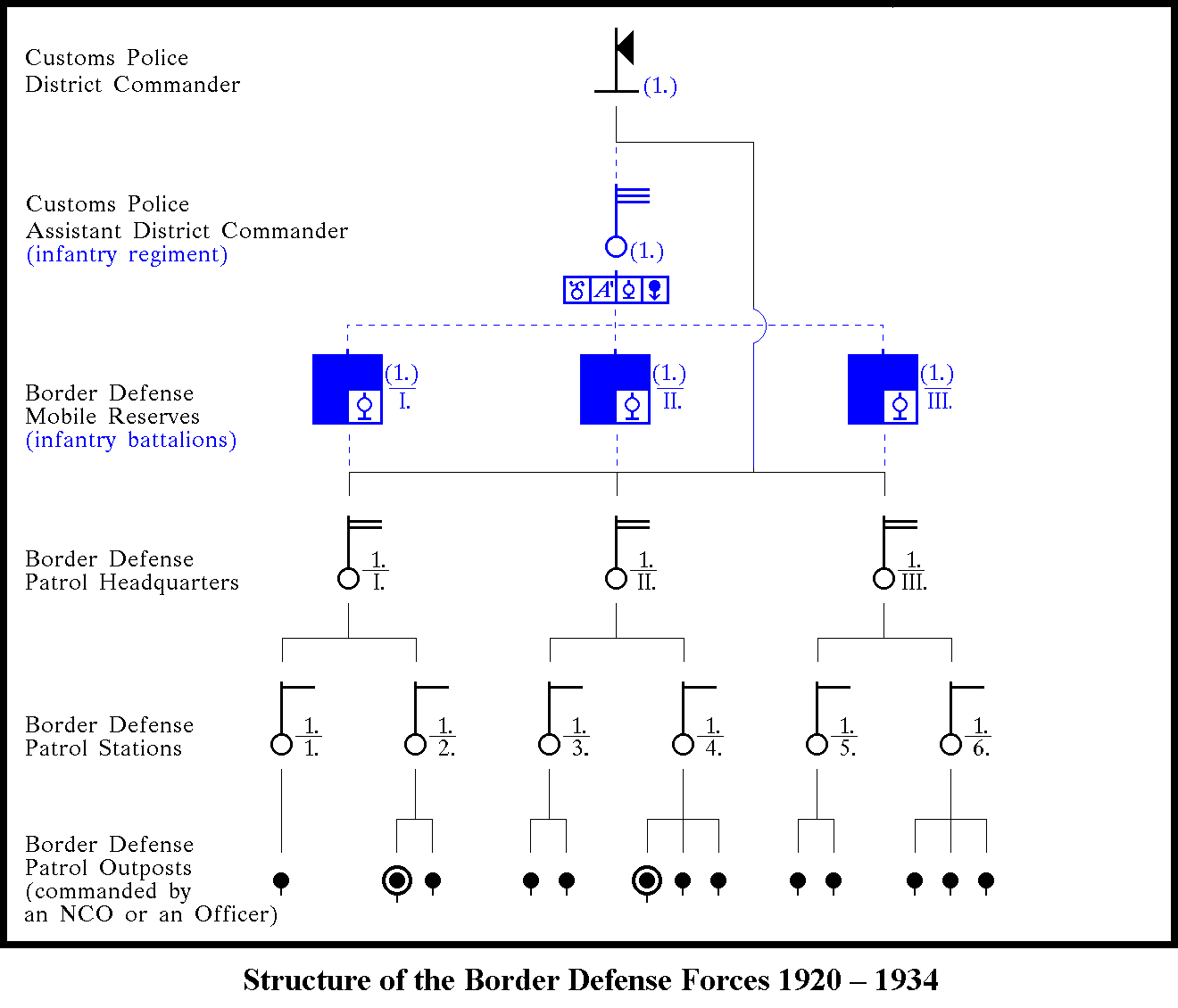
Hungarian Military Organizational Symbols The Customs Police (Vámörség) was raised in 1920. At that time, it had the strongest and best trained formations that existed in Hungary, consisting of regular soldiers transferred to civilian duty. The Customs Police was organized into seven Customs Police Districts, the boundaries of which corresponded exactly to those of the seven mixed brigades. The Customs Police was officially subordinate to the Ministry of the Interior. However, the Inspector General of the Customs Police was unofficially subordinate to the Army and functioned as the Assistant Inspector General of the Infantry. The Customs Police were supposedly only to patrol Hungary's borders for smugglers and collected customs duties. However, the Customs Police had Border Defense (Határörizet) units to protect and guard the borders. They were subdivided into patrol stations and patrol outposts along the borders. Patrol outposts were commanded either by NCO's or junior officers. Behind this line of outposts and stations, there were so-called half battalions, (with two infantry and one machine gun company) which were initially disguised as small mobile reserve formations. In actual fact they were to become full-fledged infantry battalions. Their main purpose was to act as training units for future units and to act as reserves. These were battalions built up to regimental strength by 1930. They consisted only of infantry, and were assigned to a "Customs Police Assistant Commander" (Hök. Pkh.), who in all practicality functioned as a regimental commander, (Határör Kerületi Parancsnok Helyettes). The Customs Police Assistant Commander also raised the regimental units. By 1930 the Customs Police had 7 full Border Defense regiments consisting of three battalions and regimental units each. In 1934, the Customs Police was redesignated as Border Police (Határörség). The organization remained basically unchanged. The infantry units received further training. A Border Guard battalion was formed in each district. During this period, the "Border Police Assistant Commanders" were so strong that they were able to raise a second regiment upon mobilization and were the third brigades of the corps. In 1938, the "Border Police Assistant Commanders" were officially transferred to the Army and was now openly incorporated into the corps, and renumbered as the 15th through 21st Infantry Regiments. In some cases, units were switched back and forth between Customs Police and the Army. For example, in 1937 the I./10 Infantry Battalion was redesignated as the III./5 Customs Police Battalion. The only difference to that of the Army Infantry was the arms colors, that of the Infantry being green only, whereas the Customs Police had green on red. From 1938 through 1942 the organization and locations of the border defense units had to be constantly changed, as the new territories regained by the various awards and annexations had resulted in enormously lengthened borders. In the Fall of 1938 seven Border Guard brigades were formed from the 29 Border Guard battalions. The brigades each had a signal platoon, and between 3 to 5 Border Guard battalions. The reorganization of the corps areas on 01.03.1939 meant that the I Corps no longer had a border with a foreign country. The 7th and 8th Border Guards were assigned to the VIII Corps. The Border Guard battalions (with signal, pioneer, antitank rifle, and mortars platoons), were supposed to have three infantry and one MG companies, as well as a bicycle company and a mountain artillery battery. This organization could not be finalized, as in 1939 the 2nd Vienna Award brought further territories to be guarded, and five new battalions had to be raised. Of the 34 battalions, only two (as of 1940 increased to four) in the VIII Corps territory could be raised to this organization and equipped as mountain troops. Seven Border Guard battalions only had two infantry companies, and the remaining 25 only had one infantry company. Only 11 battalions could be provided with mountain artillery batteries. With the establishment of the IX Corps during 1940–1941, 18 Border Guard battalions were transferred to the Infantry and used to raise the 25th, 26th, and 27th Székel Infantry Regiments in that area. The bicycle companies of these battalions were used to raise the bicycle battalions (each with two bicycle infantry companies) of the II, VII, and VIII Corps. The 1st through 7th Border Guard Brigades (II – VII Corps) were dissolved in 1940 – 1941. Sixteen Border Guard battalions were relocated, and the 9th Border Guard Brigade raised in the Székel Corner. The border defense duties of these units were taken over by Border Police battalions (Portyázó Zászlólj – Po.). By Spring of 1941 there were 238 Border Police stations, 16 Border Guard battalions, 2 Border Guard brigades (8th and 9th) and 4 Border Guard groups (66th, 67th, 68th, and 69th). The Border Police battalions were to raise full-strength infantry battalions upon mobilization. Mountain Troops [Source: Page 35, Part C, Darnoy, Organisation der kgl.ung. Honvéd Armee] Mountain troops were not raised until after the return of the Transylvanian Carpathians in 1939. On 01.10.1939 the 1st Mountain Brigade was raised under the new VIII Corps. The battalions of the 7th and 8th Border Guard Brigades were mountain equipped. Border Guard units were considered elite units, manned by selected volunteers, the cadre for these units was based on experienced skiers and mountain climbers. Officers and NCO were also volunteers, and were sent to special mountain training courses. The 1st Mountain Brigade was initially organized as follows: Brigade Headquarters 3 Mountain Battalions • Battalion Headquarters • Field Telephone Platoon • Pioneer Platoon • Mortar Platoon (4× 81mm mortars) • Mountain Battery (4× 75mm Guns) • 3 Mountain Infantry Companies • 1 Machine Gun Company (12× HMG) Mountain Cavalry Company Motorized Antitank Company Armored Car Platoon Motorcycle Platoon Mountain Engineer Company Mountain Bridge Column Motorized Mountain Signal Company Mountain Pack Mule Supply Company The mountain Border Guard battalions had the same organization as the mountain infantry battalions. In 1940 a fourth battalion was added to the organization of the 1st Mountain Brigade. A fifth battalion followed in late 1941. The equipment of all mountain companies was standardized at 12 light MG, 2 light mortars (50mm), and 1 antitank rifle (20mm). The mortar platoons were strengthened to 6 medium mortars (81mm). The battalion artillery batteries were subordinated to a newly-created brigade artillery command in battalion size, although the batteries stayed in the same garrisons as their battalions. Cavalry [Source: Pages 36–35, Part C, Darnoy, Organisation der kgl.ung. Honvéd Armee] Hungarian Military Organizational Symbols The official designation for cavalry regiments in the Hungarian Army was Huszár (Hussar). Large formations used "Cavalry" (Cavalry Brigades and later the Cavalry Division). Units of Huszár regiments were designated Saber companies. Independent companies as Huszárs. Although Hungary had a long and famous cavalry tradition, the Bolshevik Party only managed raised one unit: the Red Huszár Regiment. Interestingly enough, the troops of this regiment were apparently very anti-communist. The Red Army leaders considered the regiment so politically unreliable that they would not even use it against the invading Slovaks or Rumanians. The Székel Division operating in Transylvania only had one cavalry company. Horthy's National Army took over the Red Huszár Regiment in August 1919. By the end of 1919, a second regiment was raised. The regiments consisted of two battalions of 3 saber and 1 MG companies each. There was also one pioneer and one field telephone platoon in each regiment. Officers and NCO's comprised 25% of the total strength. The enlisted men were only present for shifts of six week at a time. 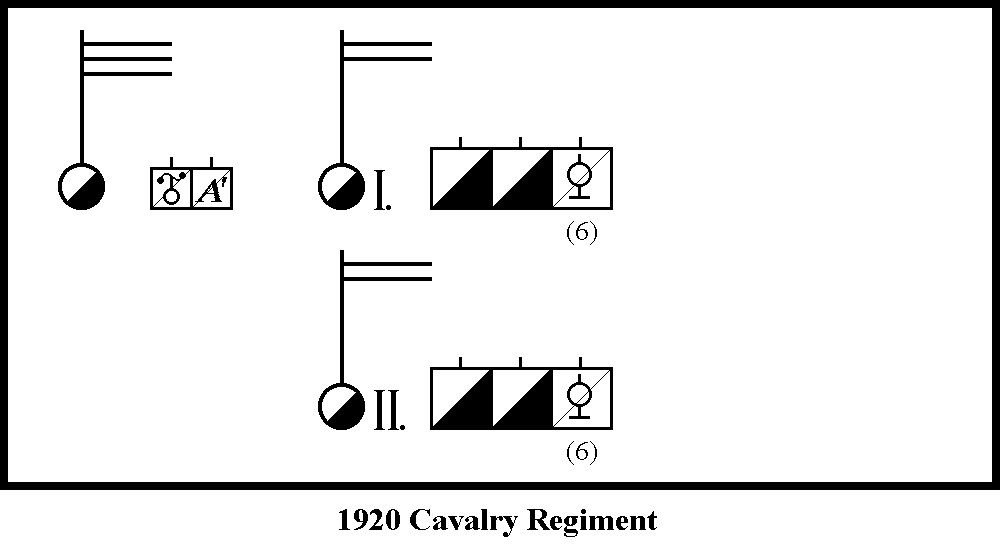 In 1920 further two Huszár regiments were raised. The four regiments were formed into two independent brigades.
The saber companies had a strength of 160 men. Owing to the lack of adequate remounts,
many of the troops were on foot. Equipment, clothing, and arms were scarce.
In 1920 further two Huszár regiments were raised. The four regiments were formed into two independent brigades.
The saber companies had a strength of 160 men. Owing to the lack of adequate remounts,
many of the troops were on foot. Equipment, clothing, and arms were scarce.
In 1920, the Huszár regiments were organized as follows: Regiment Headquarters • Mounted Telephone Platoon • Mounted Pioneer Platoon 2 Battalions • 2 Saber Companies • 1 Mounted MG Company (6 HMG) During the forced reorganization imposed by the Entente of 1922–1923, the brigades were dissolved. One Saber company per regiment also had to be dissolved, and the total personnel strength reduced by half. The superfluous troops were in part used in covert organizations or discharged. 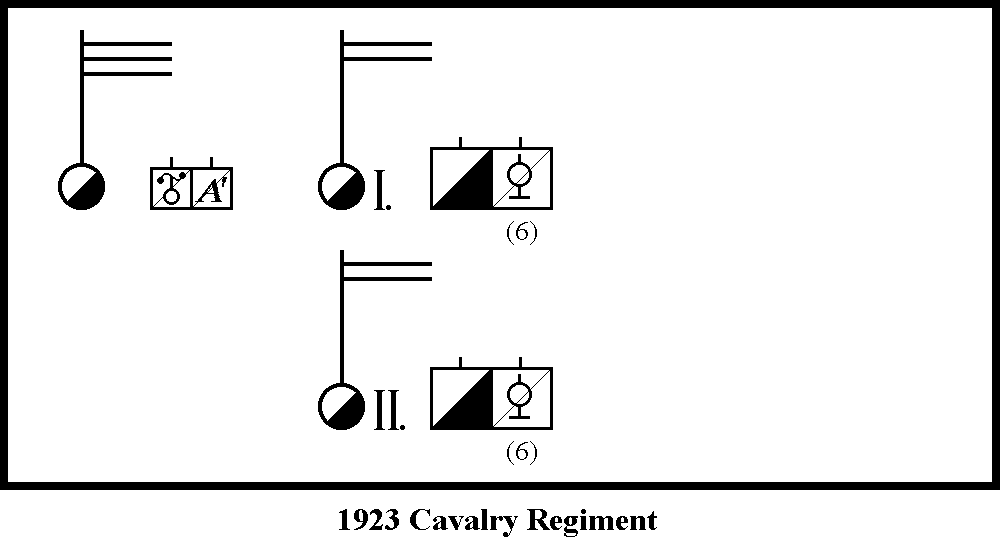
In order to avoid the sharp eyes of the Control Commission, two new covert cavalry brigades were raised, using the Huszár companies of the mixed brigades as well as the remnants of the Huszár regiments. The covert brigade commanders were carried on the roles of the mixed brigades as "Cavalry Staff Officer". However, they had no staffs, and had no Inspection rights over the Huszár regiments. This privilege was reserved for the Cavalry Inspector, who also became the commander of a cavalry division (which then would consist of the two brigades) upon mobilization. The cavalry brigades were dependent upon the mixed brigade's services. Of the men and material freed by the enforced disbanding of cavalry units during 1922 – 1923 and willing to enlist for 12 years, five – later seven – new independent Huszár companies were raised as Royal Gendarmerie Mounted Sections. They wore the uniforms of the Royal Gendarmerie, were moved to other garrisons, and placed under the Royal Gendarmerie Inspectorate. In actual fact, they remained the covert cavalry units of the mixed brigades. Starting in 1928 two cavalry brigades were raised and carried openly on the order of battle. Personnel strengths were increased, thereby enabling the formation of the second saber companies in each battalion again. The military service obligation for cavalrymen was reduced to six years, later to two years, thereby enabling the establishment of an adequate reserve pool of trained men. In 1931 the Army even experimented with a 5 month military obligation. Enough reserve officers were formed by retraining older officers and providing courses within the Huszár regiments themselves for new officers. The remount problem was solved by the regiments buying the horses, training them, and then lending them rent-free to the agrarian economy, subject to inspection by the Army. The farmers were obliged to care for the horses and keep them in good condition. In case of mobilization, the horses were to be returned to the regiments without delay. After five years, the horses automatically became the property of the farmers. Starting in 1932, the modernization of the cavalry arm was begun. Arms and equipment were updated. The telephone platoons, as well as the saber and mounted MG companies received modern radios. Machine guns was increased. Large scale maneuvers were held. During the Fall of 1938, the Royal Gendarmerie Mounted Sections were openly carried as the corps cavalry units, and would form the Huszár companies of the infantry brigades upon mobilization. 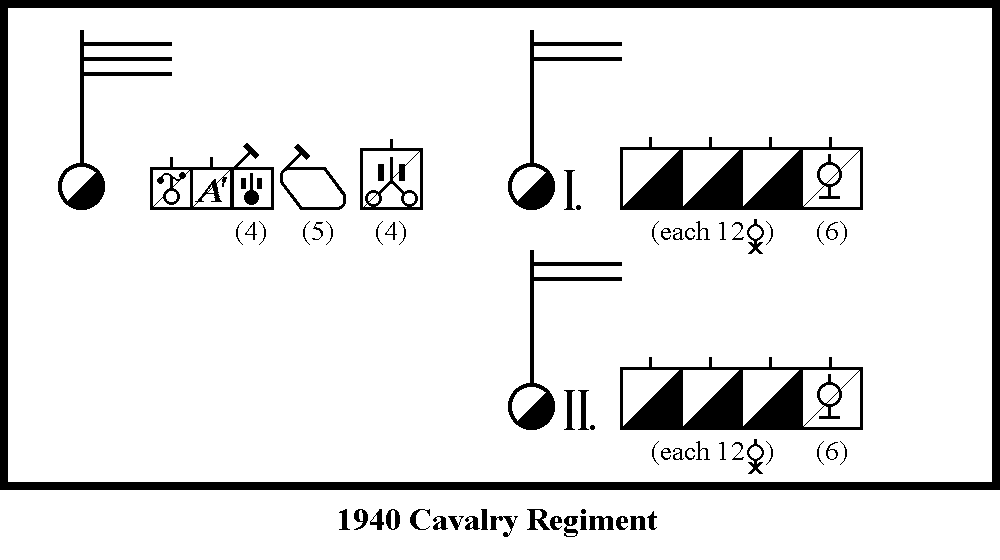 The modifications in accordance with the Huba Plan could only be
begun as of 01.10.1939, but was still not finished by the target date of
01.04.1940, as events interrupted the reorganization, and the Huszár
regiments were forced to mobilize again and again. On 11.11.1938 the
reoccupation of northern Hungary; in Spring 1939 Ruthenia; in Fall 1939
and Spring 1940 Transylvania and the Székel Corner. Although reduced
training and reorganization were carried out in the mobilized areas, the
target dates could not be met.
The modifications in accordance with the Huba Plan could only be
begun as of 01.10.1939, but was still not finished by the target date of
01.04.1940, as events interrupted the reorganization, and the Huszár
regiments were forced to mobilize again and again. On 11.11.1938 the
reoccupation of northern Hungary; in Spring 1939 Ruthenia; in Fall 1939
and Spring 1940 Transylvania and the Székel Corner. Although reduced
training and reorganization were carried out in the mobilized areas, the
target dates could not be met.
The Huba Plan now incorporated bicycle and motorized elements into the former pure horse-mounted formations. A third saber company was added to the battalions. The sabre companies were authorized 12 light MG, the mounted MG companies 12 heavy MG. By the end of 1940, the planned antitank and tankette platoons were still missing. In short supply were the newly authorized machine guns. Reconnaissance battalions were completely missing. On 01.10.1940, the cavalry brigades were assigned to the Mobile Corps (raised 01.03.1940) in Budapest. Just prior to the 1941 Yugoslavian Campaign, some of the missing equipment and units were issued to the cavalry brigades. In was foreseen that each brigade receive a tank battalion, but this was not achieved. The VIIIth independent Huszár company was formed for the newly-raised VIII Corps. A new mountain cavalry company was raised for the 1st Mountain Brigade. The forming of the independent IXth Huszár and the independent Székel Huszár companies was postponed. In Spring 1941, there 33 cavalry companies in the Army, which could expand (bud) to 49 companies upon mobilization. Bicycle Troops [Source: Pages 46–48, Part C, Darnoy, Organisation der kgl.ung. Honvéd Armee] Hungarian Military Organizational Symbols From 1922 through 1938, the bicycle troops were part of the infantry combat arm. They had been raised from the independent and light battalions of the former National Army, and were considered elite troops. 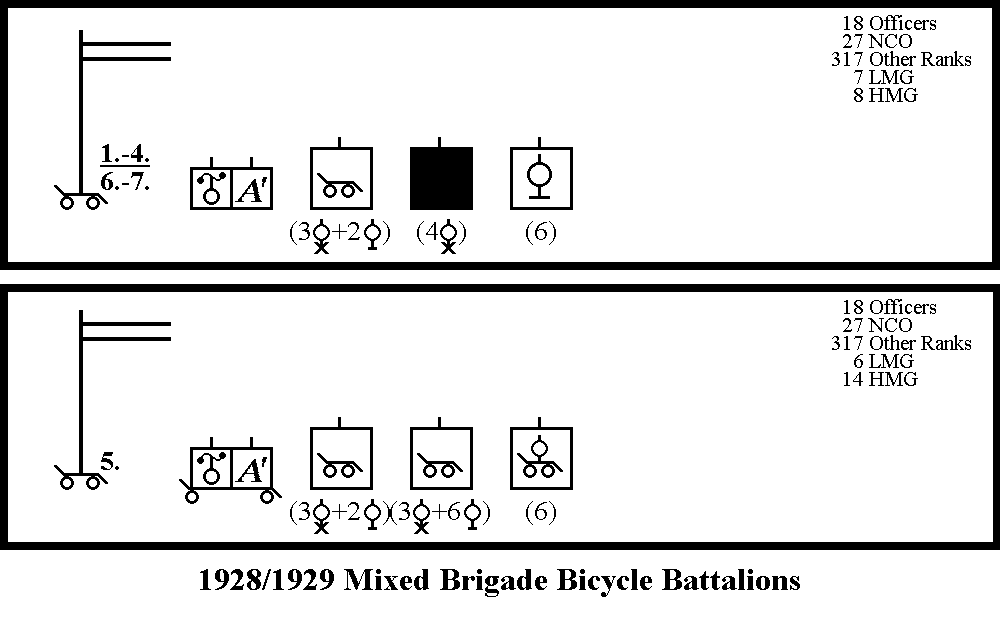 The 1921/22 organization imposed by the Entente foresaw only seven
bicycle battalions (1st – 7th), one for each mixed brigade. During the
period between 1922 and 1928, various new units were raised at the
expense of the bicycle battalions. By 1929 Bicycle Battalions had the
following organization:
The 1921/22 organization imposed by the Entente foresaw only seven
bicycle battalions (1st – 7th), one for each mixed brigade. During the
period between 1922 and 1928, various new units were raised at the
expense of the bicycle battalions. By 1929 Bicycle Battalions had the
following organization:
Battalion Headquarters • Field Telephone Platoon • Pioneer Platoon 1 Bicycle Infantry Company 1 Infantry Company (on foot) 1 MG Company (on foot) The 5th Bicycle Battalion was organized slightly differently, as follows: Battalion Headquarters • Field Telephone Platoon • Pioneer Platoon 2 Bicycle Infantry Companies 1 Bicycle MG Company By 1939, all companies had received bicycles, and a motorcycle platoon was incorporated into each battalion. 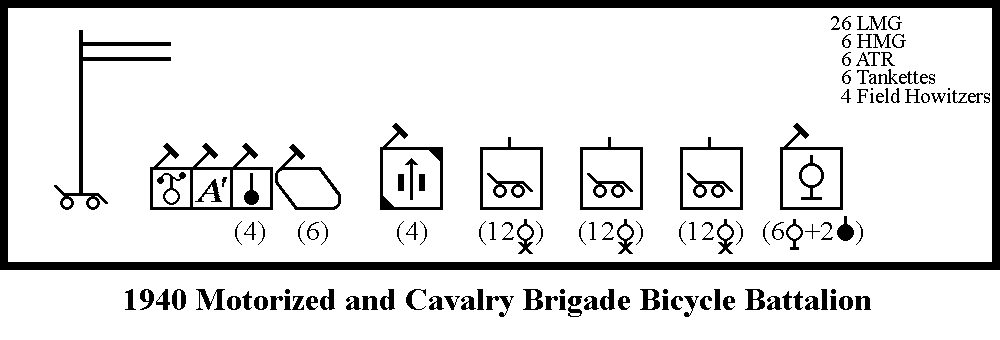 The subordination of the bicycle units to the brigades ceased in
1938, and the battalions were gathered under a "Bicycle Leader" (later
redesignated as Bicycle Commandant). Upon mobilization, this command was
to become an independent Bicycle Brigade.
The subordination of the bicycle units to the brigades ceased in
1938, and the battalions were gathered under a "Bicycle Leader" (later
redesignated as Bicycle Commandant). Upon mobilization, this command was
to become an independent Bicycle Brigade.
In 1940 these eight bicycle battalions were were reorganized, renumbered, and then transferred to the brigades under the Mobile Corps, and thoroughly reorganized, all units except the three bicycle companies were motorized, and included a halftrack-towed battery with four German 105mm field howitzers, as well as a platoon of six, (in some diagrams only five), Italians CV 3 tankettes. battalions were reorganized, renumbered, and then transferred to the brigades of the Mobile Corps.: 1st became 14th 2nd became 16th 3rd became 10th 4th became 15th 5th split and became the 9th and 13th 6th became 12th 7th became 11th The battalions were alloted as follows: 1st Motorized Brigade: 9th and 10th 2nd Motorized Brigade: 11th and 12th 1st Cavalry Brigade: 13th and 14th 2nd Cavalry Brigade: 15th and 16th 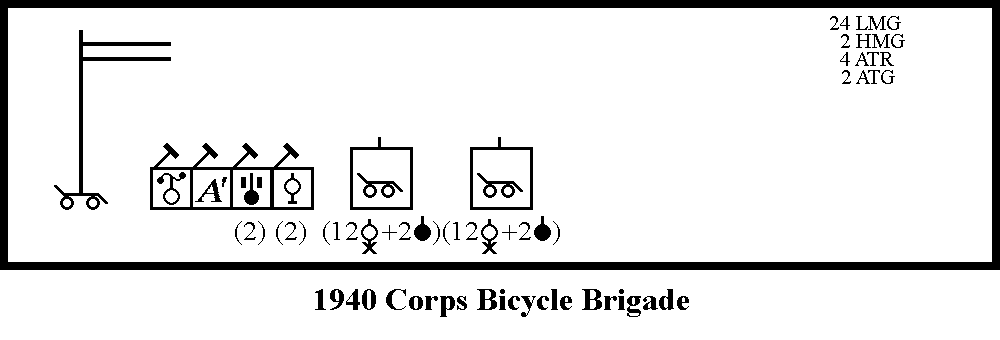 The corps were also supposed to receive a bicycle battalion, albeit much smaller than
those of the mobile brigades, (with one infantry and two bicycle companies). The IInd,
VIIth, VIIIth were raised in 1940; the VIth, Vth, IXth in 1941). The Ist, IIIrd, and
the IVth Corps Bicycle Battalions were not raised at all. Furthermore, new independent
companies were raised for the Border Guards.
The corps were also supposed to receive a bicycle battalion, albeit much smaller than
those of the mobile brigades, (with one infantry and two bicycle companies). The IInd,
VIIth, VIIIth were raised in 1940; the VIth, Vth, IXth in 1941). The Ist, IIIrd, and
the IVth Corps Bicycle Battalions were not raised at all. Furthermore, new independent
companies were raised for the Border Guards.
During this same period, the brigades in the VIIIth Corps (22nd, 23rd, and 24th) had independent bicycle companies owing to a lack of remounts. Later, when enough horses became available, they also recieved cavalry companies. By 1942 most of the bicycle battalions had been converted. In 1941 the 9th and 11th Bicycle Battalion had become the 31st and 32nd Tank Battalions, respectively. Starting late 1941, a further four bicycle battalions of the mobile brigades were used to raise tank battalions. (The 10th = I./1, the 12th = I./2, the 13th = I./3, the 16th = I./4). Only the 14th (until 1943) and the 15th (under the new 1st Cavalry Division until the end of the war) remained equipped with bicycles. The corps bicycle battalions were dissolved in 1943, and the components were used to form the bicycle companies of the divisional reconnaissance battalions. The bicycle troops, (popularly known as "Rubber Huszárs"), proved themselves in various maneuvers as well as the movement into the Carpathian territories in 1939. But the major problem the bicycle troops had was keeping up with the motorcycle and motorized infantry, as they were virtually round-bound. When they moved cross-country, the bicycles had to be carried along, (or left behind), which severely hampered mobility. The immediate aim was to equip the bicycle troops with modern cross-country motor vehicles and tanks as soon as possible. Ultimately, the infantry was to be equipped with armored halftracks. This remained no more than a dream. Smaller units mounted on bicycles, such as those raised within the infantry regiments as reconnaissance platoons, were not part of the Bicycle Troops. Mobile Troops The Treaty of Trianon had forbidden Hungary modern mobile troops and tank units. The Entente Control Mission prevented the raising an armored force of any kind until 1927, or even from owning armored vehicles except those expressly allowed in the Peace Treaty. In 1920, the core of what was later to become the Hungarian armored force was formed under the cape of the police as the "Police Recruit School" (RUISK) in Budapest. The officers and NCO's were taken over from the Army, but wore uniforms of the police. Enlisted men had to be recruited. This small unit had several Italian Bianchi and Fiat armored cars, as well as German Erhardt M-l7 armored cars and a few German LK II tankettes, several armored trains and mock-up soft skinned tanks for training purposes. During 1922 – 1924, a further 9 LK II were purchased from Germany, making a total of 14 of these tankettes. On 01.07.1929 the Armored Vehicle Group (páncéljármüves osztag) set up in Budapest. It was the first "open" armored unit raised from the under cover RUISK and from the bicycle troops. The police reassigned 2036 men to the Army during the period of 01.07.1928 through 01.07.1930. In 1935, the Armored Vehicle Group was transferred to Hajmáskér, where the artillery training school offered better opportunities to create a real armored force. The next year the Hajmáskér Mobile Group (Hajmáskéri gépkocsizó csoport) was raised there using the Armored Vehicle Group. It consisted of a motorized infantry battalion, a tank battalion, (with three companies of 16 Ansaldo CV3 tankettes each, bought from Italy in 1935), a motorized artillery battalion (with 3 batteries of light howitzers), a motorized pioneer company, a motorized signal platoon, and motorized services. In 1936 Hungary bought a further 100 CV3 tankettes from Italy, all delivered by 1937. It also bought more 105mm light field howitzers and corresponding 3-ton halftrack towing vehicles from Germany. In 1937 the 1st Mobile Brigade was raised in Hajmáskér from the Motorized Group. It consisted of 3 motorized infantry battalions, 1 bicycle battalion, 1 artillery battalion, and 1 signal platoon. In 1937/38, the 2nd Mobile Brigade was raised with the same organization. The two motorized brigades, the two cavalry brigades, and the bicycle brigade formed the heart of Hungary's mobile reserve in case of mobilization. This call up to mobilization would also create the Mobile Corps, under the command of the Inspector of the Mobile Troops. The Italian CV3 were also issued in 5 tankette platoons to the brigade bicycle battalions During the time of increased tensions in Europe, the two mobile brigades were raised to 80% strength, i.e., some reserves were called up, and services mobilized. On 01.10.1939 the mobile brigades were redesignated as motorized brigades. In 1939 was a critical year for the budding Hungarian armored forces. In the beginning, Hungary had been forced to rely on Italian armored vehicles, as the Germans showed no interest in selling either German tanks or the production licences there for. Although deliveries of German tanks were often discussed, and even vaguely promised at times, no tanks were received from this source. The Hungarian leadership decided to have its own industry build the desired armored vehicles. It was known that indigenous steel was inferior to that which Germany produced, but again armor plate would not be forthcoming from there. The serious expansion of the mobile forces began in 1941, when the first tank production orders were issued to Hungarian motor vehicle factories. As discussed previously, the Huba Plan schedule foresaw two armored divisions and one mechanized division by 1943. The Mobile Corps was raised on 01.03.1940 at Szolnok, and assigned all mobile formations available to the Army at the time. The commander of the Mobile Corps was simultaneously the Inspector of Mobile Troops, which included the Inspectors of the Bicycle Troops, the Motorized Infantry Troops, and the Cavalry Troops. In the Spring of 1940, the first armored reconnaissance battalions were raised. They initially consisted of one armored car platoon (5 Csaba), one motorized infantry company (12 light MG and 2 antitank rifles), one tank company (with Italian CV3 tankettes). Training was carried out on a broad basis. A tank training camp and a tank firing range were set up at Kenyérmezö (near Esztergom) in 1940. The brigade had a regimental commander with a small staff to enable portions of the brigade to carry out special missions away from the brigade. The regimental commander functioned as the assistant brigade commander. During the first stage, one battalion per brigade was to be converted tanks to be equipped with Italian Ansaldo CV3 tankettes. Owing to the lack of tanks, the 9th and 11th Bicycle Battalions were only partially equipped with tanks, and consisted of battalion headquarters, Sapper, signal, and maintenance platoons, plus two light tank companies and two bicycle companies. 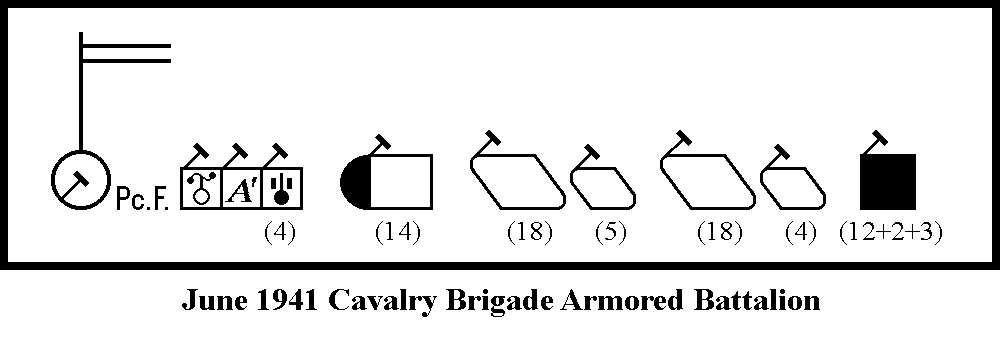
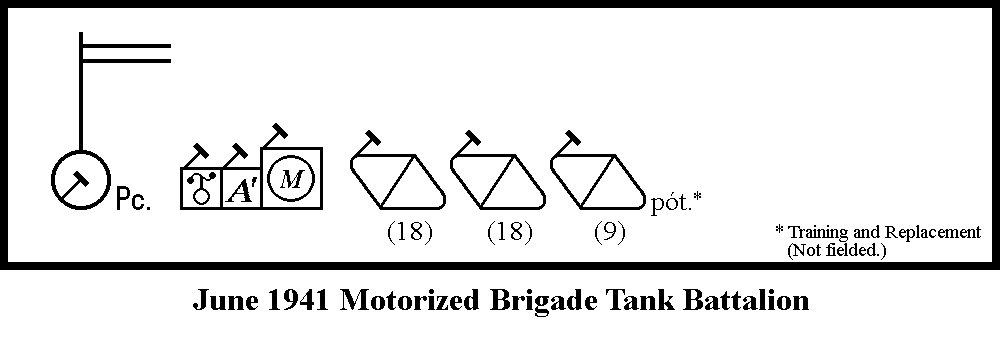
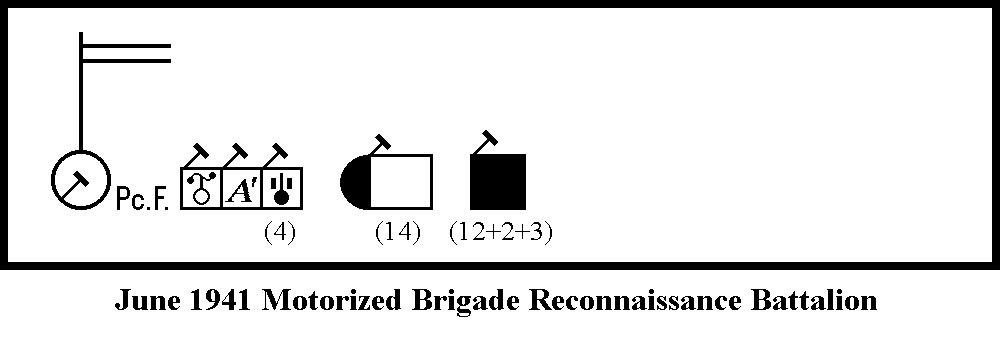 By early 1941, the motorized brigades had achieved the form in which
they participating in the 1941 Yugoslavian. However, in June 1941, the armored units within
the four brigades were reorganized, just in time for the 1941 Russian Campaign.
By early 1941, the motorized brigades had achieved the form in which
they participating in the 1941 Yugoslavian. However, in June 1941, the armored units within
the four brigades were reorganized, just in time for the 1941 Russian Campaign.
By Fall 1942, this had been developed into a modern armored school. Officers and NCO's were formed into training companies specializing in mobile troops tactics. The "Csaba Királyfi" military cadet academy in Marosvásárhely was opened to train upcoming generations of officers in mobile warfare. The new organization under the Huba III Plan – to take effect on 1.03.1942 – scheduled the raising of the 1st and 2nd Armored Divisions. Their establishment was planned for the Fall of 1941, using the various components of the two motorized brigades. By 01.03.1942, these two divisions should then have been combat ready. The organization of these new tank battalions foresaw: Battalion Headquarters • 1 pioneer platoon • 1 signal platoon • 1 maintenance platoon 3 tank companies (light Toldi) 1 tank company (medium Turán) 2 companies with Nimrod armored, self-propelled antiaircraft vehicles each. The armored units of the 1st and 2nd Cavalry Brigades were slightly altered, with a single cavalry tank battalion each, consisting of 1 armored car company, 2 tankette companies with Ansaldo CV3, losing the motorized infantry company, but augmented with 1 maintenance platoon and 1 supply platoon. During the second phase, all the other bicycle battalions were to be converted to tank battalions. This plan was not achieved. Hungarian industry was not able to meet the demands made upon it to produce enough armored vehicles. The mobilization for and participation in the 1941 Russian Campaign caused further delays in the completion of the plans, so that the finalization was postponed until Spring 1942. The losses experienced by the two motorized brigades in 1941, (mainly due to natural causes and normal wear and tear) were irreplaceable. The promised German tanks were not sent to Hungary. The losses in motor vehicles could not be replaced, as the Hungarian motor vehicle industry was overextended with building tanks for Hungary and armaments for Germany. Personnel had been trained, but material was missing. This remained the unfortunate situation of the Hungarian armored forces until the end of the war. By the end of December 1941 the Hungarian industry was behind in deliveries of equipment for 10 tank companies and 14 artillery batteries. Motorization The development of Hungary's army into a modern force was consistently hampered by the lack of motor vehicles. This bottleneck was to accompany the Army throughout the war, and severely limited the mobility of the combat forces and their support services. The capacity of the automotive industry was limited between the wars, although the quality of the vehicles was above normal. To protect this small industry, the government imposed high import duties on foreign motor vehicles. Those motor vehicles available to the Army in 1932 were mainly outdated, some even from World War I, and comprised a broad spectrum of makes and models. Modest amounts of automobiles were purchased in 1932. The Army acquired Italian artillery prime movers from Pavesi and Breda. Limited license production of Pavesi tractors was also started in Hungary, designated as KV-40 and KV-50. (These looked like regular farm tractors, without a driver's cab, with large wheels in the back and small wheels in the front, etc., – and had a single cylinder, diesel engine). Specially designed Csepel cross country trucks were bought for the signal troops. Other cross-country trucks bought were the Rába-Super and the MÁVAG-Mercedes types. Cars acquired were of many different types, including Italian Fiats. In 1936, Hungary bought 1000 civilian Ford 2˝ ton trucks from the factory in Cologne, Germany. These were used to equip the Mobile Brigades, and were supposed to serve until Hungary could acquire German cross country trucks (such as the Krupp L2H-143) and Hungary could produce enough Csepel trucks. The slow start in motorization was unable to catch up with the expansion of the Army which started in 1938. The possibility of acquiring motor vehicles from Italy or Germany was small, as these countries had begun their own military expansion. This meant that there less motor vehicles in all of Hungary in 1938 – including all civilian vehicles – then would be required by the Huba Plan for the Army by 1941. The desolate situation of its motor vehicle park had already became abundantly clear to the Royal Hungarian Army in 1938 when it reoccupied the territories regained in the 1st Vienna Award, particularly in the supply services. The grave situation was further emphasized in 1940 after the 2nd Vienna Award, when the Army moved into northern Transylvania and the Székel Corner. Again, the supply situation became chaotic. Long columns of horse-drawn wagons as well as the rapid deterioration of the older motor vehicles provided many headaches for both the troops and the higher commands. This same situation was repeated when Hungary mobilized in early 1941. Parallel to the Huba Plan, the General Staff had also implemented a motorization program designed to provide the Army with the needed motor vehicles. This was the Botond I Plan. Unfortunately, the Hungarian industry's motor vehicle production capacity was still very limited. Furthermore, this sector was also engaged in the manufacturing of armored vehicles, which took up a great part of this limited capacity. Improvements in production techniques as well as joint efforts by various companies were hampered by limited possibilities. From 1938, the Hungarian automotive industry, which included the manufacture of railroad equipment, was primarily engaged in the export of its products. The construction of trucks had a low priority, as there had been very little demand in Hungary until 1937. Some experiments were made with heavy cross-country trucks. The Army had been a minor customer. Only 40 of the Csepel trucks were ordered for the signal troops. As indicated, Hofherr Schranz delivered 700 KV-40 and KV-50 tractors, (under license of Pavesi), for the air defense forces. For motorization of the local Home Air Defense they were adequate. For field use, however, these vehicles proved to be unsuitable, as they were too slow and technically obsolete. The Györ Wagon Factory only received small orders for its license-built 1˝ ton Rába-Austro-Fiat (AFI) model, namely 200 until 1943, and a further 100 in 1943. A similar situation existed for the license-built MÁVAG-Mercedes 1˝ ton truck and the Rába-Super 2˝ ton truck, although the latter received government support to speed its introduction into the civilian economy. 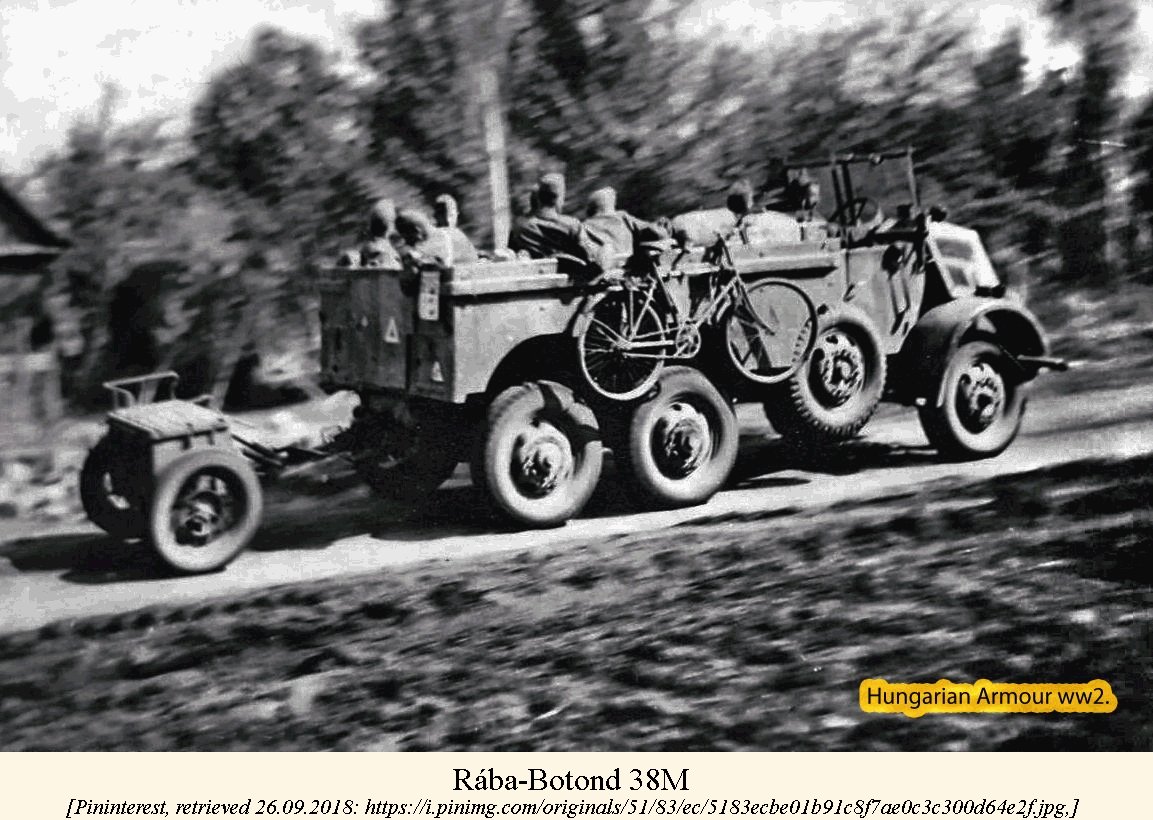
In line with the Botond I Plan, the Army ordered 1,402 cross-country Rába-Botond trucks, designed to transport a section of 12 men. It could also tow the 40mm antiaircraft gun. Delivery was punctual. By July 1939, 150 had been accepted. The rest one year later. The Rába-Botond trucks proved to be a good design which performed well under field conditions. On 01.12.1940, the Army had the following motor vehicles: 643 motorcycles 724 cars 953 trucks 362 ambulances 162 cross-country cars 1,882 cross-country trucks These vehicles, assuming all were in condition to be used, were insufficient to fulfil the planned requirements of the Army upon mobilization. One peacetime strength 1941 Motorized Brigade needed 67 motorcycles, 225 motorcycles with sidecars, 98 cars, 462 trucks (1˝ ton), 135 trucks (3 ton), 28 signal trucks, and 24 artillery prime movers. These figures do not include the brigade staff and supply services. No improvement in motorization had been achieved by early 1941. The Huba Plan III phase later that year did nothing to change the situation. Upon mobilization, the Honvéd Ministry planned to requisition 2000 trucks from the civilian sector. The General Staff regarded this plan with great skepticism, commenting that so many trucks could not be taken without completely disrupting the economy, and doubting that many of them would be in any condition suitable for military use. The mobilization of the 3 brigades of the Mobile Corps in 1941 caused enormous problems. Just barely enough motor vehicles could be found. In some cases, the brigade supply units were more than a week late in reaching their deployment areas owing to the delays encountered in first gathering and then servicing the necessary vehicles. The Mobile Corps lost 1200 motor vehicles in the 1941 Russian campaign. This was a major setback for the motorization of the Army, as it was now further back than it had been in 1940. In 1941, the Honvéd Ministry started the Botond II Plan. It ordered 1400 trucks from the Hungarian industry. These vehicles were delivered in 1942/43. The Army had to requisition a large part of the vehicles it needed to fill its requirements from the civilian sector in case of mobilization. This occurred under the most difficult circumstances and caused grave friction between the military and the civilian authorities. The process severely interfered with the economy, and the results were not nearly as productive as the Army would have liked. The majority of civilian vehicles were not very modern and in rural areas quite worn if not unusable. They could only be used in Hungary. For field use, many of these requisitioned vehicles were worthless. In 1938, there were 3,903 civilian trucks registered in Hungary. Of these, 524 Rába-Super and 414 MÁVAG-Mercedes were of Hungarian production. Between 1938 and 1943 this number increased by about 4,000 trucks including some 50 foreign makes and models, although only 200 were of Hungarian manufacture. Motorized vehicles could not be efficiently replaced by their horse-drawn counterparts. Supply columns became dangerously long, exposing them to partisan and air attacks. Delays caused by these slow-moving columns often had fatal consequences for the fighting units. The capacity of a horse-drawn column was 30 tons. One wagon – which also had to carry its own team's fodder – could carry a payload of 600 kilos. Each horse-drawn supply column had 3 platoons of 25 wagons drawn by four horses each, and 10 wagons drawn by two horses for its own support. Taking into consideration the daily distance a horse-drawn column could cover, this capacity could be mastered by 3 to 5 medium 3-ton trucks instead. The many motorized units in the Order of Battle of the Army represented a misleading picture. Because of the dependence upon requisitioned civilian motor vehicles in case of mobilization, units did not know what they were getting. In many cases, the requisitioned vehicles turned out to be unusable, and the unit could not be motorized. Armored Fighting Vehicles Hungary had acquired 12 Fiat L2 armored cars from Italy during 1930 – 1932. One prototype by Manfréd Weiss and Rába each were bought for testing. Besides the 12 LK II tankettes bought during the 1920's, the Army bought only a few other tanks before deciding on the Fiat Ansaldo tankette. The initial 50 Fiat/Ansaldo Carro Veloce tankettes (30 CV 3/33 and 20 CV 3/35) arrived in 1936, and a further 100 CV 3/35 in 1937. Unconfirmed sources indicate that several CV 3/35 of the former Austrian Army were acquired from Germany after the Anschluss. The Hungarians were well aware at that time these vehicles did not meet the criteria of modern combat vehicles. By 1941 most of the CV tankettes were worn out. In 1939 Hungary acquired 9 TK-3, 7 TKS, and 3 Renault R-35 tanks by default from Polish Army units which retreated onto Hungarian territory after the fall of Poland. Hungary had no experience in armored vehicle production itself until 1938, and the beginnings were difficult. First attempts at a national production in cooperation with Italian companies proved unfruitful. Neither Germany nor Italy were willing to sell license rights to the armored vehicles they were building. The Hungarians were forced to look to their own or other sources. The first Hungarian tank, the V-4, was built by Manfréd Weiss in Budapest-Csepel. 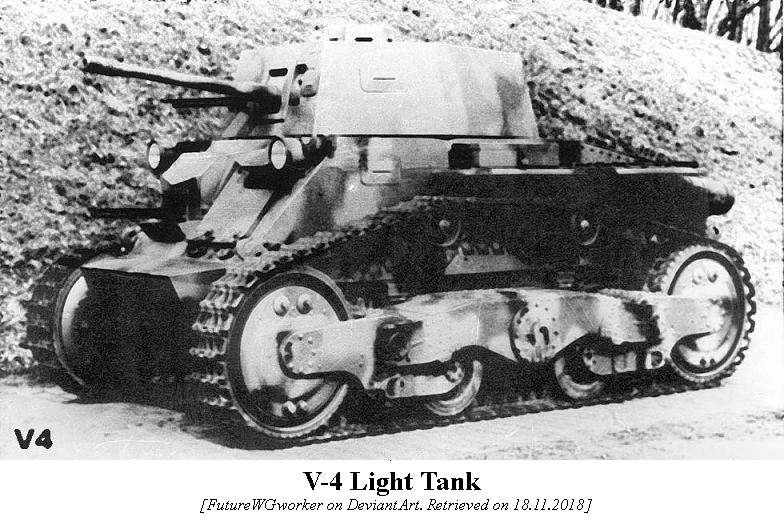 It proved to be technically deficient, and the initial
order of 100 vehicles was rescinded by the Honvéd Ministry.
It proved to be technically deficient, and the initial
order of 100 vehicles was rescinded by the Honvéd Ministry.
The Army had acquired only a few national and foreign light armored vehicles for limited use and testing. The first armored vehicle to be acquired in large quantities was the Csaba armored car, based on the Strausser AC-III, a British-built, Hungarian-designed vehicle. Under the provisions of the Huba I Plan, Manfréd Weiss received an order to develop an armored car armed with a 20mm gun. The prototype was demonstrated in June 1939. Production of the initial order of 3 trail vehicles, 8 mild steel, and 50 fully-armored vehicles started in 1940, and the first 3 trail models of the pancélgépkocsi 39 M. Csaba were introduced into troop use in January of the same year. Delivery of rest of the vehicles was completed by June 1940. Twelve command versions – armed only with a machine gun – were built concurrently and designated as the pancélgépkocsi parancsnoki 39/40 M. Csaba. Under the Huba II Plan, a further 50 Csabas were ordered, 32 of which were accepted in 1942, and the remaining 18 in 1943. The first tank ordered by the Army was the license-built Swedish Landsverk L-60 tank. The initial order was for 80 light tanks. It was introduced in April 1940 as the könnyü harckocsi 38 M. Toldi I. The next model was the Toldi II, (könnyü harckocsi 38 M. Toldi II) with a production run of 110. It had an additional 20mm of armor. Delivery took place from May 1941 through 1942. Hungary also needed a medium tank. After lengthy, nonproductive negotiations with Italy and Germany, Hungary managed to acquire the production rights for the Skoda T-21 tank in August 1940 from the Czech Republic. Two mild-steel prototypes were demonstrated in July 1941. In accordance with the Huba II Plan, the Army ordered 230 vehicles (70 to Manfréd Weiss, 70 to Magyár Vagon, 50 to Ganz, and 40 to MÁVAG). This medium tank equipped with a 40mm gun, and designated as the közepes harckocsi 40.M Turán I. The Turán program was delayed by the return of the Toldi light tanks involved in the 1941 campaign. Most of these had to be returned to the factories for major repairs or to correct serious technical defects. Series production was in any event still behind due to various technical difficulties, so at the turn of 1941/1942, the medium tank was still not available. Finally, the first 22 Turán tanks arrived at the tank training school at Esztergom in June 1942. The last Turán I were accepted in 1943. An order for 215 vehicles under the Huba III Plan was placed in July 1941, but modified in May 1942 to 124 vehicles, of which only 55 were delivered. The last vehicles from this batch were accepted in May 1944. Based on the experiences of the 1941 campaigns, the Ansaldo tankettes were withdrawn from front-line service. Field Artillery 
Hungarian Military Organizational Symbols The terms of the Treaty of Trianon severely limited amount and type of artillery the fledgling army was allowed. Hungary could have no more than 105 guns of not more that 105mm caliber, although in 1922 four 149mm howitzers were allowed. Mortars were also fixed in number. During the period of 1920 – 1930, the Army had 7 field artillery battalions and 7 mortar companies, which were assigned to the 7 mixed brigades. The brigades contained an artillery commander with a small staff within their headquarters, in charge of all artillery within the brigade, and who was also responsible for its training. So-called "Assistant Artillery Commanders" were also present who would raise further battalions in case of mobilization. Although the World War I equipment was already outdated and under caliber, tactical use was efficient and firing standards were very high. The field artillery battalions were organized into 3 batteries of 4 guns. The 1st battery had 75mm 15.M mountain pack guns, the 2nd battery had 76.5mm 18.M and 5/8.M field guns, and the 3rd battery had 100mm 14/a.M field howitzers. The mortar companies had two platoons. The 1st platoon had 5 medium 90mm 17.M mortars, the 2nd platoon had 5 heavy 140mm 18.M mortars. Starting in 1928, the Army began to improve and expand its artillery arm. The first step in the organizational process was on 22.04.1926 when the Artillery Group Hajmáskér was raised at Hajmáskér, (north of Lake Balaton), and redesignated as the Artillery Training Grounds Command on 30.04.1928. The school taught artillery crews and trained ordnance specialist. It also provided courses for artillery officers and higher artillery commanders. On 16.07.1928, the first horse artillery battalion was raised from the GHQ unit. It had two batteries of four 75mm 15/35.M horse-drawn mountain guns each. It was destined to support the two cavalry brigades. In 1928 the battalion organization changed slightly, so that it had three double two-gun "half-batteries", each with 75mm 15.M mountain pack guns, and 100mm 14/a.M light field howitzers. This enabled training within the batteries to prepare the creation of new batteries. The mortar companies were assigned to the field artillery battalions as the 4th battery. An artillery calibration battery was raised for each of the brigades. During 1930 – 1934 the half-batteries were expanded to full batteries, although still with only two guns each. The assistant artillery commanders were used to raise new battalions. This meant that the artillery "battalions" were regimental size and until 1934 had two battalions, and after 1934 even three battalions. After 1938, these battalions became the artillery battalions of the mixed brigades (each with 5 batteries). Hungary manufactured its own light field artillery, and although the industry had a low production capacity, improved equipment was steadily introduced. Between 1934 and 1935, forty batteries were reequipped with 160 of the new 75mm 15/35.M horse-drawn mountain guns. The batteries were equipped with a variety of guns. The mortars were replaced with guns as soon as they became available, and disappeared from the artillery organizations after 1935. During 1934 – 1938, the "battalions" had three battalions, and an artillery calibration battery. There was also a horse-drawn independent 149mm 14.M heavy field howitzer battery. The 14.M was replaced by the 14/35.M or 14/39.M. In 1936 a motorized artillery group was raised at Hajmáskér. It consisted of a motorized artillery battalion (with 3 batteries of German 10,5cm le.F.H. 37) and several half-batteries for training purposes. The motorized artillery for the 1st Motorized Brigade was raised from this group in 1937, and for the 2nd Motorized Brigade in 1938. In early 1938, the artillery had a peace time strength of 92˝ batteries, of which only 15% were motorized. The corps had 63 horse-drawn light field gun batteries as well as 7 horse-drawn batteries with 149mm equipment. The two motorized brigades and the two cavalry brigades had 3 batteries each, for a total of 12 motorized batteries. Starting with the Army reorganization in 1938, artillery battalions were no longer kept covert, and assumed their proper numbering within the peace time order of battle. GHQ artillery received numbers over 100. The batteries of the bicycle battalions were also converted to German 10,5cm le.F.H. 37. The Border Guard was reinforced by 11 batteries with four 75mm 15/35.M mountain guns each. In 1939, the field artillery was further strengthened and standardized. The establishment of the VIII Corps meant that new headquarters and batteries had to be raised. Thus the new 22nd, 23rd, and 24th Artillery Battalions, as well as the VIIIth independent heavy artillery battery came into being. In addition, the 1st Mountain Brigade received one gun battery (with four 75mm 15.M mountain pack guns), for each of the four mountain infantry battalions. Starting in 1939, the two-gun field gun, mountain gun, and light field howitzer half-batteries were filled up to full batteries with four guns each. By 1940, the 24 artillery battalions of the corps had the 1st and 2nd Batteries with 100mm 14/a.M or 14/b.M light field howitzers. Conversion to the German 10,5cm le.F.H. 37 had begun. (The plan foresaw that the 2nd battery of all 24 battalions would have the German field howitzers). The 3rd Battery had 149mm 14/35.M heavy field howitzers. The corps heavy independent artillery batteries were motorized. The raising of the IX Corps in Transylvania, as well as various regrouping measures, meant that the planned complete standardization of equipment in all battalions could not be achieved. To facilitate the raising of further batteries upon mobilization, the 2nd batteries were authorized a strength of 6 guns in peace time. By 1941, there were 131 batteries in the Army, meaning that there was only one artillery battery for each infantry battalion, which the General Staff considered insufficient. The artillery of the peace time infantry brigade as of 1941 was subordinate to an artillery regiment staff, the commander of which was also the brigade artillery officer. The Ist Battalion had three batteries. The 1st and 2nd batteries had four 76.5mm 5/8.M field guns, the 3rd Battery had 100mm 14/a.M light field howitzers. The IInd Battalion had four batteries. The 4th Battery had four 100mm 14.M light field howitzers. The 5th Battery was supposed to have four German 10,5cm le.F.H. 37. The 6th and 7th Batteries had four 149mm 14.M (or 14/35.M or 14/39.M) heavy field howitzers. The corps artillery of the peace time army had two motorized independent batteries with four 149mm 15/31.M field howitzers. General Headquarters Artillery 
Hungarian Military Organizational Symbols Although heavy artillery had been forbidden by the terms of the Treaty of Trianon, Hungary had managed to hide 4 super heavy 305mm howitzers left over from World War I. Heavy artillery – traditionally known as GHQ artillery – as fixed by the Trianon organization was originally limited to four independent batteries. This was reduced to three in 1922. The Entente Control Commission made it impossible to create heavy GHQ artillery battalions. The antiaircraft batteries were used to form what would later become the air defense units of the air force. This situation did not change until 1935, although, as mentioned before, the Artillery Group Hajmáskér had been raised on 22.04.1926. It had begun training the cadre of what was to be the basis for all GHQ artillery units. It was redesignated as the Artillery Training Grounds Command on 30.04.1928. The development of the heavy GHQ motorized artillery was slow. Up to 1935 only three motorized batteries of two guns each had been raised. They were again used as further training cadres for future units. The guns were medium 105mm 31.M guns, 149mm 31.M field howitzers, (both introduced in 1938), and the outdated super heavy 305mm 11.M and 16.M howitzers. These three batteries were gathered under the Artillery Group Hajmáskér. An artillery ordnance workshop was also raised for the Group at Hajmáskér. After the introduction of the Huba Plan in 1938, the Artillery Training Grounds Command was redesignated as the 101st Artillery Brigade. Two new units (101st and 102nd Motorized Heavy Artillery Battalions) were raised, supplemented by new batteries. Each battalion had two batteries. As the Army had no modern heavy artillery, the batteries were equipped with 149mm 31.M medium howitzers. Upon mobilization, the GHQ artillery could raise 10˝ batteries at that time. During the years 1939/1940, each of the two heavy battalions received a third battery. The third battery of the 101st Battalion had two heavy 210mm 39.M howitzers; the third battery of the 102nd Battalion had one super heavy 305mm 16.M howitzer. Starting in 1938, 210mm heavy howitzers were acquired (39.M, 40.M and 40/a.M). These were used to raise the number of GHQ battalions to four, (101st, 102nd, 103rd, and 150th), as well as one independent battery (104th). In 1940 the super heavy 305mm howitzers were removed from service. However they were one again pressed into service early 1942, when four one-gun batteries were raised (151st – 154th). In 1941, all GHQ artillery was attached to the field artillery for training and reorganization. Links to 1941 authorized organizations: Army Corps Infantry Brigade Mountain Brigade Border Guard Brigade Motorized Brigade Cavalry Brigade Air Defense and Antiaircraft Troops The terms of the Treaty of Trianon limited the number of antiaircraft guns to a total of four. This meant that Hungary had no air defense to speak of, although the neighboring countries of Rumania, Yugoslavia, and Czechoslovakia all had aircraft. The Army was also allowed two batteries of outdated 80mm 5/8.M antiaircraft guns. In addition, there were two antiaircraft batteries belonging to the River Forces, which had been raised by removing a number of guns carried on board of the ships. The four batteries had a total of 16 guns, and were located at Budapest, Hajmáskér, Miskolc, and Bája, respectively. There was also a searchlight platoon in Budapest-Tökökugrató. This meagre force was used as a training cadre to form the basis of the air defense in later years. In 1928 this task was taken over by the new Budapest Air Defense Command (Budapesti légvédelmi parancsnokság). The command had two independent batteries of four 80mm 5/8.M antiaircraft guns. One battery was in Budapest. One half-battery was in Miskolc, the other in Hajmáskér. The antiaircraft school was also based in the latter location. The Air Defense Act of 1935 provided the basis for the air defense of Hungary and the raising of antiaircraft units. The Budapest Air Defense Command was expanded into the National Air Defense Command, and made responsible for all air defense units, measures, and institutions. An air defense officer was incorporated into the corps staffs. All over Hungary measures were taken to the establish air defenses. The emphasis was on national defense against air attack. 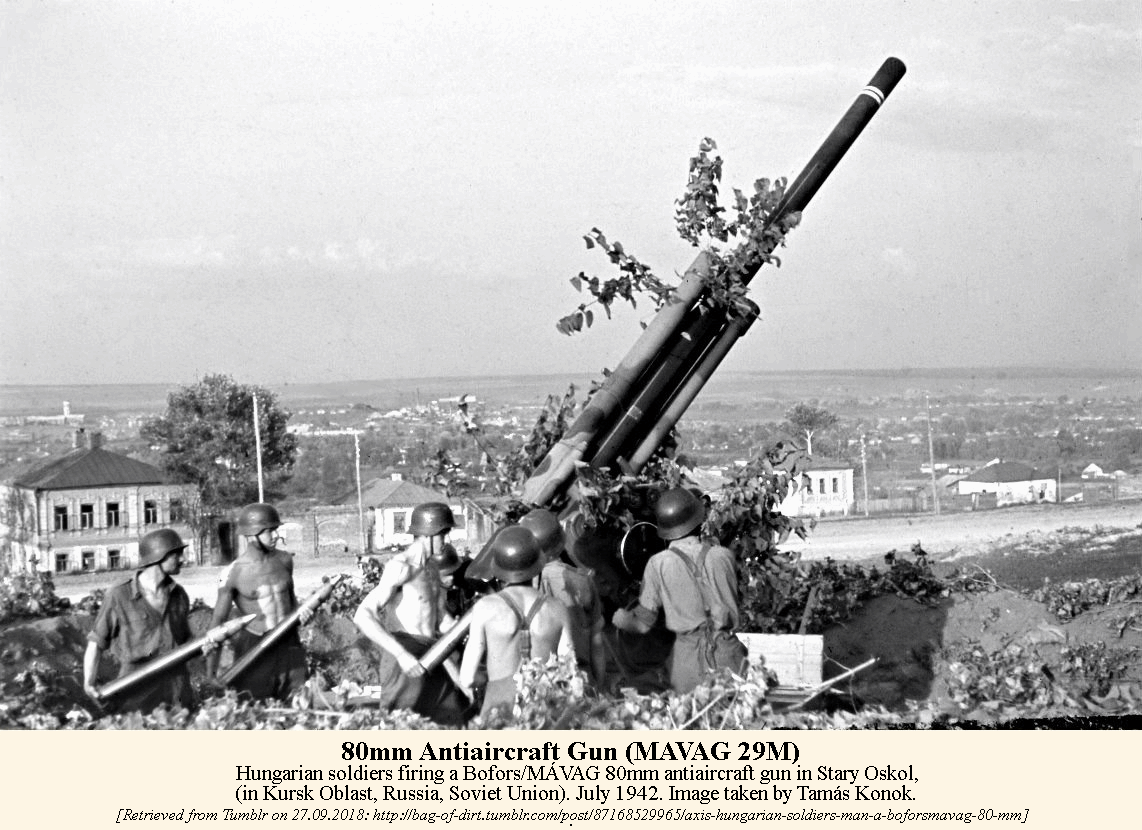
By 1939, eight antiaircraft battalions (Ist – VIIIth) with two batteries each had been raised and added to the corps organization. One was a firing battery with two Bofors/MÁVAG 80mm 29.M guns. The other was a training battery. The antiaircraft troops were formed into a separate combat arm under the Artillery Inspectorate. All antiaircraft units were tactically subordinate to the National Air Defense Command. The battalions remained logistically assigned to their corps. Civilian air defense was somewhat varied. Part of it was based on community authorities and voluntary organizations, being subordinate to the Ministry of the Interior. On the other hand, the Air Defense League (Légoltalmi Liga) was a civilian organization supported by the community administrations and the industry, and was controlled by the Honvéd Ministry. Regulations came from the National Institute for Air Defense (Országos Légoltalmi Intézet). All authority for air defense measures was delegated to the Honvéd Ministry, which designated the National Air Defense Command (OLP) in Budapest to administer these activities. The Armed Forces Act of 1938 — besides subjecting all Hungarian citizen to a military and labor obligation — also enacted an air defense obligation for all citizens, (including females), from 14 years of age through 70. Besides fire departments, communal and other organizations, air defense also was based on air defense troops. The nine corps had antiaircraft battalions (a IXth had been added since the recovery of Transylvania). Budapest at this time had an air defense regiment and an special battalion (kárelhárito). Air observation, early warning, and communications systems were fitted with modern signal and alarm equipment. The warning and evaluation centers were located in bunkers, and had telephone and radio contact to a wide net of observation posts, especially in Transylvania, where the main enemy (Rumania) was presumed. Notwithstanding the national air defense obligation, most communal air defense services and even the postal communications network were manned by volunteers. In the Fall of 1938, the 101st – 104th Air Defense Battalions were raised for home air defense. They had two (heavy) batteries with four 80mm antiaircraft guns. In 1939, a third (light) battery was added with four 40mm 36.M antiaircraft guns to each battalion. The 105th Air Defense Battalion was raised in 1939 with three heavy and one light batteries. Also in 1939, a light battery was added to the Ist – Vth and VIIth Antiaircraft Battalions. The VIth Antiaircraft Battalion received two light batteries. In 1940, each brigade received an independent antiaircraft battery. The organization of all antiaircraft battalions was standardized at one heavy and two light batteries. The home defense batteries were issued a fifth gun. In March 1941, the Army had 43 antiaircraft batteries, of which 24 were equipped with 80mm guns. In the Spring of 1941 the five home defense battalions were removed from the direct control of the General Staff and assigned to the newly created Air Defense Corps. The corps was subordinated to the air force, and the five air defense battalions each raised (budded) a second battalion (201st – 205th), thereby giving the Air Defense Corps a strength of 10 battalions with about 30 batteries. A heavy battalion (206th) with four batteries was also raised. Only the two light batteries were equipped. Two other two batteries for 105mm antiaircraft guns were also formed, but these had no equipment for years, as Germany did not deliver the paid-for eight 10,5cm Flak 38 guns until March 1944. The rapid increase of air defense units was based in part on the antiaircraft training battalions. (Each corps had one firing and one training antiaircraft battalion on its peace time establishment). But the main reason was that Hungary produced its own 40mm and 80mm antiaircraft guns, based on Bofors licenses. Nevertheless, the Army was unsatisfied with what it considered to be the weak air defense potential of Hungary as well as that of its combat formations.
* * *
|
| Ranks of the Hungarian Army | |||||||||||||||||||||||||||||||||||||||||||||||||||
|
|
||||||||||||||||||||||||||||||||||||||||||||||||||